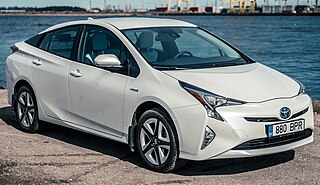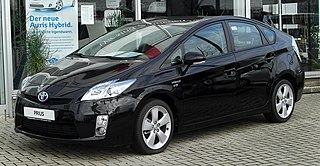
The Toyota Prius is a compact/small family liftback produced by Toyota. The Prius has a hybrid drivetrain, combined with an internal combustion engine and an electric motor. Initially offered as a four-door sedan, it has been produced only as a five-door liftback since 2003.
The California Air Resources Board is an agency of the government of California that aims to reduce air pollution. Established in 1967 when then-governor Ronald Reagan signed the Mulford-Carrell Act, combining the Bureau of Air Sanitation and the Motor Vehicle Pollution Control Board, CARB is a department within the cabinet-level California Environmental Protection Agency.

The Honda Insight is a hybrid electric vehicle that is manufactured and marketed by Honda. Its first generation was a two-door, two passenger liftback (1999–2006) and in its second generation was a four-door, five passenger liftback (2009–2014). In its third generation, it became a four-door sedan (2018–2022). It was Honda's first model with Integrated Motor Assist system and the most fuel efficient gasoline-powered car available in the U.S. without plug-in capability for the length of its production run.
A partial zero-emission vehicle, in the United States, is an automobile that has zero evaporative emissions from its fuel system, has a 15-year warranty on its emission-control components, and meets SULEV tailpipe-emission standards.

A zero-emission vehicle (ZEV) is a vehicle that does not emit exhaust gas or other pollutants from the onboard source of power. The California definition also adds that this includes under any and all possible operational modes and conditions. This is because under cold-start conditions for example, internal combustion engines tend to produce the maximum amount of pollutants. In a number of countries and states, transport is cited as the main source of greenhouse gases (GHG) and other pollutants. The desire to reduce this is thus politically strong.

The Toyota RAV4 EV is an all-electric version of the popular RAV4 SUV produced by Toyota until 2014. Two generations of the EV model were sold in California, and to fleets elsewhere in the US, with a gap of almost ten years between them.
Canadian Car of the Year winners, as chosen by the Automobile Journalists Association of Canada:

The Toyota RAV4 is a compact/mid-size crossover SUV produced by the Japanese automobile manufacturer Toyota. It is known for starting the wave of compact crossovers. The RAV4 is one of the best-selling SUVs of all time. By February 2020, a total of 10 million RAV4s had been sold globally.

The Los Angeles Auto Show, also known as the LA Auto Show, is an auto show held annually at the Los Angeles Convention Center in Los Angeles, California, United States. It is open to the public for ten days, filling 760,000 square feet (71,000 m2) of exhibit space. Since 2006 the event is held in November or December.
An ultra-low-emission vehicle (ULEV) is a motor vehicle that emits extremely low levels of motor vehicle emissions compared to other vehicles. In some jurisdictions it is defined in law; low and ultra low emission vehicles may be given tax or other advantages, while high emission vehicles may suffer restrictions or additional taxation.
United States vehicle emission standards are set through a combination of legislative mandates enacted by Congress through Clean Air Act (CAA) amendments from 1970 onwards, and executive regulations managed nationally by the Environmental Protection Agency (EPA), and more recently along with the National Highway Traffic Safety Administration (NHTSA). These standards cover tailpipe pollution, including carbon monoxide, nitrogen oxides, and particulate emissions, and newer versions have incorporated fuel economy standards. However they lag behind European emission standards, which limit air pollution from brakes and tires.

The Honda CR-Z is a sport compact hybrid electric car manufactured by Honda and marketed as a "sport hybrid coupe." The CR-Z combines a hybrid gasoline-electric powertrain with traditional sports car elements, including a 2+2 seating arrangement and a standard 6-speed manual transmission.
The BMW M56 is a 2.5-liter 184-PS straight-six engine. It is a re-engineered version of the BMW M54B25 engine, manufactured in order to meet SULEV regulations in US states until 2006. The M56 was replaced by the BMW N54, which was BMW's first mass-produced turbocharged petrol engine.

Subaru is the automobile manufacturing division of Japanese transportation conglomerate Subaru Corporation, the twenty-first largest automaker by production worldwide in 2017.

In the U.S., the seventh generation North American Honda Accord is a mid-size car that was available as a four-door sedan or a two-door coupe and was produced by Honda from September 2002 to 2007. The sedan was also marketed in parts of Latin America, Asia, Middle East, Caribbean, Australia and New Zealand markets, and also known as the Honda Inspire in Japan from 2003. The North American Honda Accord, with modifications for local market needs, was the launch vehicle of Honda in the South Korean market with sales beginning from May 20, 2004.

The Toyota Prius is a full series-parallel hybrid electric compact car developed and manufactured by the Toyota Motor Corporation. The second generation Prius had been completely redesigned with a kammback profile. The XW20 series represented the second generation of the Toyota Prius, replacing its XW10 predecessor. The United States Environmental Protection Agency (EPA) and California Air Resources Board (CARB) rated the Prius as among the cleanest vehicles sold in the United States based on smog forming and toxic emissions in 2008. Toyota sold about 1,192,000 units of the second generation Prius worldwide.

The Toyota Prius (XW10) is a subcompact hybrid car that was produced by Toyota between 1997 and 2003 in Japan. The XW10 is divided into the NHW10 and its NHW11 counterpart, both of which represent the first generation of Prius series. The Toyota Prius is the first mass-produced hybrid car, and was released 2 years ahead of other manufacturers. While the NHW10 was available exclusively to Japan, it was subsequently introduced to worldwide markets in September 2000 with the NHW11. Toyota sold about 123,000 first generation Prius. Toyota's XW10 series Prius is notable as the first vehicle based on the Toyota MC platform.

The Hybrid Scorecard was created by the Union of Concerned Scientists (UCS) to give consumers a comprehensive comparison of hybrid electric vehicles available in the U.S. market. The UCS Hybrid Scorecard ratings take into considerations fuel economy as rated by the U.S. Environmental Protection Agency (EPA); the environmental benefits as compared to its similar or closest conventional internal combustion engine counterpart; how cost-effectively a particular hybrid achieves its environmental performance; and premium features that are bundled on a hybrid as standard equipment raising its purchase price.

The stock of plug-in electric vehicles in California is the largest in the United States, and as of December 2023, cumulative plug-in car registrations in the state since 2010 totaled 1.77 million units. Between November 2016 and until 2020, China was the only country market that exceeded California in terms of cumulative plug-in electric car sales.

The A200/A250 seriesDaihatsu Rocky is a subcompact crossover SUV manufactured by Daihatsu. It was unveiled at the 46th Tokyo Motor Show on 23 October 2019 under the "New Compact SUV" name. It replaced the Be‣go in the Japanese market and went on sale on 5 November 2019. The Rocky is also rebadged and sold under Toyota and Subaru brands as the Toyota Raize and Subaru Rex respectively.














